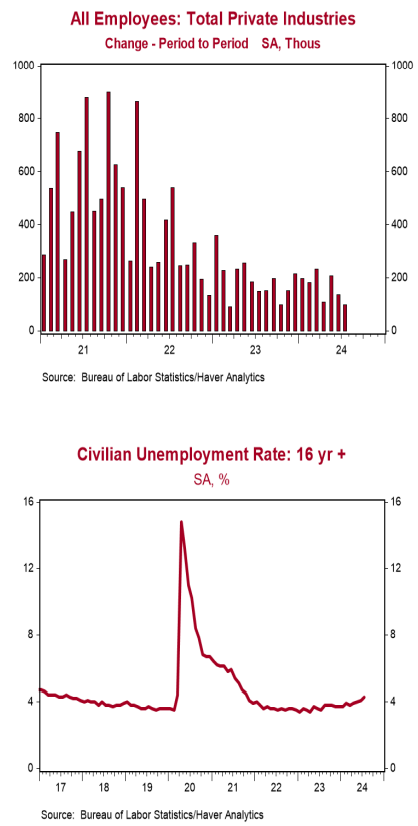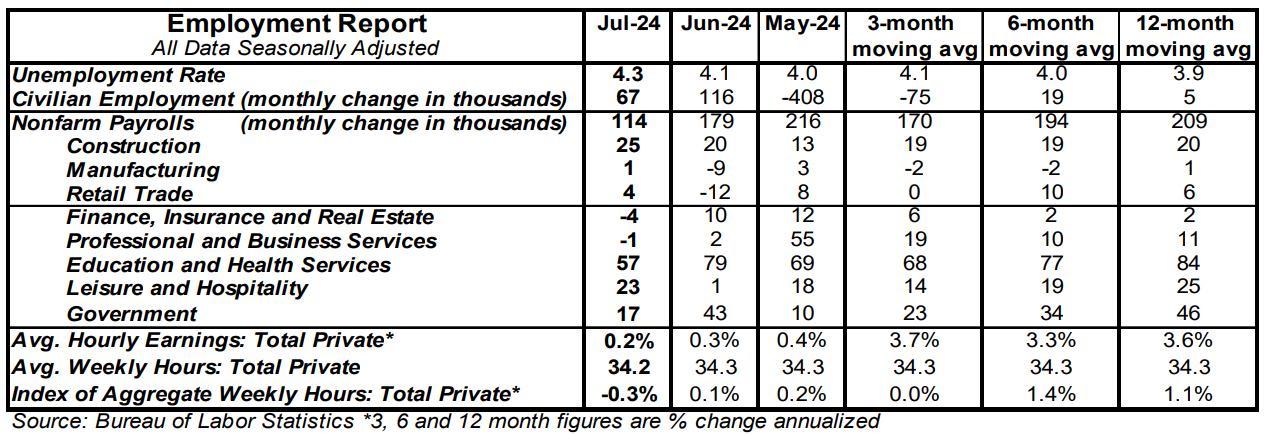- Nonfarm payrolls increased 114,000 in July lagging the consensus expected 175,000. Payroll gains for May and June were revised down by a total of 29,000, bringing the net gain, including revisions, to 85,000.
- Private sector payrolls rose 97,000 in July and were revised up by 13,000 in prior months. The largest increase in July was health care (+55,000), followed by leisure & hospitality (+23,000). Government rose 17,000 while manufacturing increased 1,000.
- The unemployment rate increased to 4.3% in July from 4.1% in June.
- Average hourly earnings – cash earnings, excluding irregular bonuses/commissions and fringe benefits – rose 0.2% in July and are up 3.6% versus a year ago. Aggregate hours fell 0.3% in July but are up 1.1% from a year ago.
Implications: The labor market was noticeably softer in July. If it gets any weaker the US may soon find itself in recession. Nonfarm payrolls rose 114,000, lagging the consensus expected 175,000, while payroll gains for prior months were revised down by 29,000. We like to follow payrolls excluding government (because it's not the private sector), education & health services (because it rises for structural and demographic reasons, usually doesn’t decline even in recession years, and is often responsive to government policies) and leisure & hospitality (which is still recovering from COVID Lockdowns). That “core” measure of payrolls rose only 17,000 in July, the smallest gain so far this year. Meanwhile, civilian employment, an alternative measure of jobs that includes small-business start-ups, rose a tepid 67,000 in July and is up only 57,000 from a year ago. Not 57,000 per month; we mean a grand total of 57,000 in the past twelve months. Notably, the household survey also shows employment among full-time workers down about 500,000 versus a year ago, with part-time employment up about 550,000. However, the labor force (people who are working or looking for work) increased 420,000. As a result of weak employment gains but a rapidly growing labor force, the jobless rate increased to 4.3% in July. That’s 0.4 percentage points higher than it was three months ago, an increase that in the past has often (but not always) been associated with a recession. Key details in the report were also not good. Total hours worked declined 0.3% in July and average hourly earnings were up only 0.2%. Hourly wages are now up only 3.6% from a year ago, which is barely above inflation. Barring a sudden surge in the inflation rate, the Federal Reserve will see all this as a solid green light to start cutting short-term interest rates in September. The M2 measure of money declined from early 2022 through late 2023; it looks like the pain associated with that tightening of monetary policy is finally starting to hit home.





